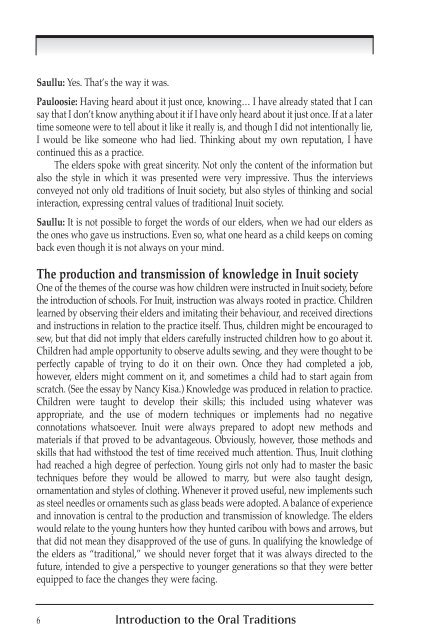Introduction-E
Introduction-E
Introduction-E
You also want an ePaper? Increase the reach of your titles
YUMPU automatically turns print PDFs into web optimized ePapers that Google loves.
Saullu: Yes. That’s the way it was.<br />
Pauloosie: Having heard about it just once, knowing… I have already stated that I can<br />
say that I don’t know anything about it if I have only heard about it just once. If at a later<br />
time someone were to tell about it like it really is, and though I did not intentionally lie,<br />
I would be like someone who had lied. Thinking about my own reputation, I have<br />
continued this as a practice.<br />
The elders spoke with great sincerity. Not only the content of the information but<br />
also the style in which it was presented were very impressive. Thus the interviews<br />
conveyed not only old traditions of Inuit society, but also styles of thinking and social<br />
interaction, expressing central values of traditional Inuit society.<br />
Saullu: It is not possible to forget the words of our elders, when we had our elders as<br />
the ones who gave us instructions. Even so, what one heard as a child keeps on coming<br />
back even though it is not always on your mind.<br />
The production and transmission of knowledge in Inuit society<br />
One of the themes of the course was how children were instructed in Inuit society, before<br />
the introduction of schools. For Inuit, instruction was always rooted in practice. Children<br />
learned by observing their elders and imitating their behaviour, and received directions<br />
and instructions in relation to the practice itself. Thus, children might be encouraged to<br />
sew, but that did not imply that elders carefully instructed children how to go about it.<br />
Children had ample opportunity to observe adults sewing, and they were thought to be<br />
perfectly capable of trying to do it on their own. Once they had completed a job,<br />
however, elders might comment on it, and sometimes a child had to start again from<br />
scratch. (See the essay by Nancy Kisa.) Knowledge was produced in relation to practice.<br />
Children were taught to develop their skills; this included using whatever was<br />
appropriate, and the use of modern techniques or implements had no negative<br />
connotations whatsoever. Inuit were always prepared to adopt new methods and<br />
materials if that proved to be advantageous. Obviously, however, those methods and<br />
skills that had withstood the test of time received much attention. Thus, Inuit clothing<br />
had reached a high degree of perfection. Young girls not only had to master the basic<br />
techniques before they would be allowed to marry, but were also taught design,<br />
ornamentation and styles of clothing. Whenever it proved useful, new implements such<br />
as steel needles or ornaments such as glass beads were adopted. A balance of experience<br />
and innovation is central to the production and transmission of knowledge. The elders<br />
would relate to the young hunters how they hunted caribou with bows and arrows, but<br />
that did not mean they disapproved of the use of guns. In qualifying the knowledge of<br />
the elders as “traditional,” we should never forget that it was always directed to the<br />
future, intended to give a perspective to younger generations so that they were better<br />
equipped to face the changes they were facing.<br />
6 <strong>Introduction</strong> to the Oral Traditions


